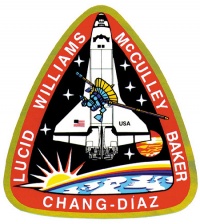STS-34
From The Space Library
 | |
| Organization | NASA-Office of Space Flight (United States) |
|---|---|
| Mission type | Earth Science,Human Crew,Solar Physics |
| Launch date | October 18, 1989 |
| Launch vehicle | Space Shuttle |
| Launch site | Cape Canaveral, United States |
| COSPAR ID | 1989-084A |
| Inclination | 34.30 degrees; first flight at this inclination |
| Experiments | Here |
| Alternate Names | SSBUV1/STS 34,20297 |
| Additional Information | Here |
| PDMP Information | Here |
| Telecommunications Information | Here |
| Data Collection | Here |
| Payload Mass Up | 22064 kg |
| Payload Mass Down | 4829.55 kg |
| Orbiter | Atlantis |
| Lift Off Mass | 2,056,465.45 kg |
| Orbiter Weight at Liftoff | 117,076.82 kg |
| Orbiter Weight at Landing | 89,070.00 kg |
| Landed | Runway 23 dry lake bed at Edwards Air Force Base, Calif. |
| Orbits of Earth | 79 |
| Orbital Altitude | 161 nautical miles (185 statute miles) |
Contents |
Crew
- Commander: Donald E. Williams
- Pilot: Michael J. McCulley
- Mission Specialist 1: Shannon W. Lucid
- Mission Specialist 2: Ellen S. Baker
- Mission Specialist 3: Franklin R. Chang-Diaz
Mission
STS 34 was the fifth flight of the Atlantis orbiter and the 31st shuttle mission. Its primary mission was the deployment of Galileo. It also carried a secondary payload experiment, the Shuttle Solar Backscatter Ultraviolet Experiment (SSBUV 1), that measured solar irradiance and radiation backscattered from the earth's atmosphere in twelve ultraviolet channels. From these data, total amount and height distribution of ozone could be derived. Essentially, the SSBUV 1 instrument was the same as the SBUV/2 instrument on-board the NOAA polar orbiting satellites except for a few added features including: (1) a transmitter diffuser to transmit sunlight to the SSBUV sensor module; (2) solar and nadir aspect sensors to measure the instruments inclination toward the sun and earth during observations; and (3) an inflight calibration system to perform calibration checks and account for calibration drift. Because of the calibration drift and instrument degradation of the SBUV/2, one main objective of the SSBUV 1 experiment was to operate both experiments in coincidence for calibration purposes. The total duration of this shuttle flight was 4 days, 23 hours, 39 minutes, and 20 seconds for a total of 79 orbits.
Payload
Deploy IUS with Galileo spacecraft; Shuttle Solar Backscatter Ultraviolet (SSBUV); Polymer Morphology (PM) experiments; IMAX camera project; Mesoscale Lightning Experiment (MLE); Air Force Maui Optical Site (AMOS) experiment; Growth Hormone Concentration and Distribution (GHCD) in Plants experiment; Sensor Technology Experiment (STEX); SSIP Student Experiment (SE) 82-15; Ice Crystals Experiment
Books about the Space Shuttle Program
Buy This Book Click here |
Buy This Book here |
Buy This Book Click here |
Buy This Book Click here |





